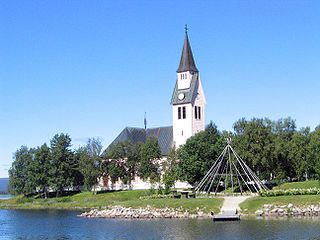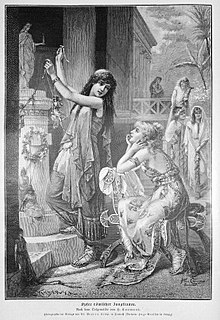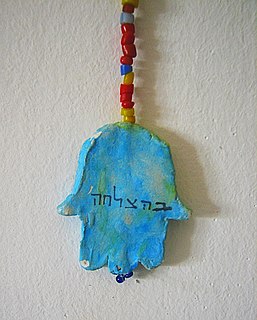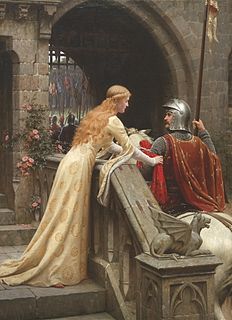
Arjeplog Municipality is a municipality in Norrbotten County in northern Sweden. Its seat is located in Arjeplog.

Traditional Sámi spiritual practices and beliefs are based on a type of animism, polytheism, and what anthropologists may consider shamanism. The religious traditions can vary considerably from region to region within Sápmi.

A Sámi drum is a shamanic ceremonial drum in the culture of the Sámi people of Northern Europe. Sámi ceremonial drums have two types: a bowl drum in which the drumhead is strapped over a burl, and a frame drum in which the drumhead stretches over a thin ring of bentwood. Both variations are oval-shaped. The drumhead is fashioned from reindeer hide.

Lars Levi Laestadius was a Swedish pastor and administrator of the Swedish state Lutheran church in Lapland who founded the Laestadian pietist revival movement to help his largely Sami congregations, who were being ravaged by alcoholism. Laestadius was also a noted botanist and an author. Laestadius himself became a teetotaller in the 1840s, when he began successfully awakening his Sami parishioners to the misery and destruction alcohol was causing them.

The Torsåker witch trials took place in 1675 in Torsåker parish in Sweden and were the largest witch trials in Swedish history. In a single day 71 people were beheaded and then burned.
Johan Johansson Griis, usually known as the Gävle Boy, was a young Swedish boy remembered for being a witness in witch trials and for bearing substantial responsibility for the witch trial of Stockholm in 1676.
Brita Zippel, also called Britta Sippel was an alleged Swedish witch, known as "Näslösan", one of the most famous figures of the great witch mania called "Det Stora oväsendet" in Sweden between 1668-1676, and the most famous of the city of Stockholm. Together with her sister Anna Zippel, she may be the most famous witch in Swedish history.
The witch trials of Vardø were held in Vardø in Finnmark in Northern Norway in the winter of 1662–1663 and were one of the biggest in Scandinavia. Thirty women were put on trial, accused of sorcery and making pacts with the Devil. One was sentenced to a work house, two tortured to death, and eighteen were burned alive at the stake.
Christence (Christenze) Kruckow was a Danish noble and alleged witch. She was one of few members of nobility executed for sorcery in Scandinavia.
Botulf Botulfsson, from Gottröra, Uppland, was a Swedish man burned at the stake for heresy. His is the only confirmed case of an execution for heresy in Sweden.
Eric Clauesson was a Swedish man executed for sorcery, theft and heresy, though in reality, this was an execution for Paganism. His case illustrates the fact that the old Pre-Christian Pagan Norse religion still lived in Sweden as late as in the 15th century.

Northern Moravian witch trials, also known as Boblig witch trials was a series of witch trials which occurred in the Jeseník and Šumperk area in present-day Czech Republic, between 1622 and 1696. They are among the largest and most well known witch trials in the history of the country.

The Mora witch trial, which took place in Mora, Sweden, in 1669, is the most internationally famous Swedish witch trial. Reports of the trial spread throughout Europe, and a provocative German illustration of the execution is considered to have had some influence on the Salem witch trials. It was the first mass execution during the great Swedish witch hunt of 1668–1676.
Gertrud Svensdotter (1656–1675) was a Swedish peasant. She was the witness and accuser in the witch trial against Märet Jonsdotter in 1668, the trial that unleashed the great witch hysteria in Sweden called Stora oväsendet, involving a series of witch trials in many parts of the nation and lasting until 1676.
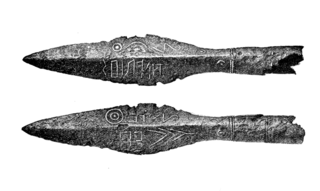
Gothic paganism was the original religion of the Goths.

The forest Sami were a Sami people who worked in the woods and who, unlike the reindeer-herding Sami people, did not move up into the fells during the summer season. Historically, there have been forest Sami in Sweden in the area ranging from northern Ångermanland to the far north. In the early 1600s the term granlapp was also used to refer to the Sami people who paid taxes only to Sweden, compared to the semi-nomadic fell Sami, who, since they worked in the fells that straddled the Swedish-Norwegian border, had to pay taxes to both countries. When Ernst Manker studied the life of the forest Sami in the early 20th century, nearly all of their habitations had been abandoned. Only one forest Sami village remained, in Malå in Västerbotten, an area known as Stenundslandet in Anundsjö.

Events from the year 1693 in Sweden
